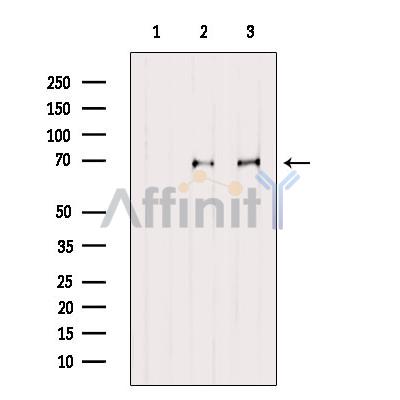MKS1 Antibody - #DF12027
| Product: | MKS1 Antibody |
| Catalog: | DF12027 |
| Description: | Rabbit polyclonal antibody to MKS1 |
| Application: | WB IHC |
| Reactivity: | Human, Mouse, Rat, Monkey |
| Prediction: | Bovine, Horse, Rabbit, Dog, Chicken |
| Mol.Wt.: | 65-70 kDa; 65kD(Calculated). |
| Uniprot: | Q9NXB0 |
| RRID: | AB_2844832 |
Related Downloads
Protocols
Product Info
*The optimal dilutions should be determined by the end user. For optimal experimental results, antibody reuse is not recommended.
*Tips:
WB: For western blot detection of denatured protein samples. IHC: For immunohistochemical detection of paraffin sections (IHC-p) or frozen sections (IHC-f) of tissue samples. IF/ICC: For immunofluorescence detection of cell samples. ELISA(peptide): For ELISA detection of antigenic peptide.
Cite Format: Affinity Biosciences Cat# DF12027, RRID:AB_2844832.
Fold/Unfold
B8d3; BBS13; Dysencephalia splanchnocystica; FABB proteome like protein; FLJ20345; Gruber syndrome; Meckel gruber syndrome; Meckel gruber syndrome type 1; Meckel syndrome; Meckel syndrome type 1; Meckel syndrome type 1 protein; Meckel syndrome type 1 protein homolog; MES; MKS 1; MKS; Mks1; MKS1_HUMAN; POC12; POC12 centriolar protein homolog;
Immunogens
A synthesized peptide derived from human MKS1, corresponding to a region within C-terminal amino acids.
- Q9NXB0 MKS1_HUMAN:
- Protein BLAST With
- NCBI/
- ExPASy/
- Uniprot
MAETVWSTDTGEAVYRSRDPVRNLRLRVHLQRITSSNFLHYQPAAELGKDLIDLATFRPQPTASGHRPEEDEEEEIVIGWQEKLFSQFEVDLYQNETACQSPLDYQYRQEILKLENSGGKKNRRIFTYTDSDRYTNLEEHCQRMTTAASEVPSFLVERMANVRRRRQDRRGMEGGILKSRIVTWEPSEEFVRNNHVINTPLQTMHIMADLGPYKKLGYKKYEHVLCTLKVDSNGVITVKPDFTGLKGPYRIETEGEKQELWKYTIDNVSPHAQPEEEERERRVFKDLYGRHKEYLSSLVGTDFEMTVPGALRLFVNGEVVSAQGYEYDNLYVHFFVELPTAHWSSPAFQQLSGVTQTCTTKSLAMDKVAHFSYPFTFEAFFLHEDESSDALPEWPVLYCEVLSLDFWQRYRVEGYGAVVLPATPGSHTLTVSTWRPVELGTVAELRRFFIGGSLELEDLSYVRIPGSFKGERLSRFGLRTETTGTVTFRLHCLQQSRAFMESSSLQKRMRSVLDRLEGFSQQSSIHNVLEAFRRARRRMQEARESLPQDLVSPSGTLVS
Predictions
Score>80(red) has high confidence and is suggested to be used for WB detection. *The prediction model is mainly based on the alignment of immunogen sequences, the results are for reference only, not as the basis of quality assurance.
High(score>80) Medium(80>score>50) Low(score<50) No confidence
Research Backgrounds
Component of the tectonic-like complex, a complex localized at the transition zone of primary cilia and acting as a barrier that prevents diffusion of transmembrane proteins between the cilia and plasma membranes. Involved in centrosome migration to the apical cell surface during early ciliogenesis. Required for ciliary structure and function, including a role in regulating length and appropriate number through modulating centrosome duplication. Required for cell branching morphology.
Cytoplasm>Cytoskeleton>Cilium basal body. Cytoplasm>Cytoskeleton>Microtubule organizing center>Centrosome.
Note: Localizes at the transition zone, a region between the basal body and the ciliary axoneme.
Restrictive clause
Affinity Biosciences tests all products strictly. Citations are provided as a resource for additional applications that have not been validated by Affinity Biosciences. Please choose the appropriate format for each application and consult Materials and Methods sections for additional details about the use of any product in these publications.
For Research Use Only.
Not for use in diagnostic or therapeutic procedures. Not for resale. Not for distribution without written consent. Affinity Biosciences will not be held responsible for patent infringement or other violations that may occur with the use of our products. Affinity Biosciences, Affinity Biosciences Logo and all other trademarks are the property of Affinity Biosciences LTD.


